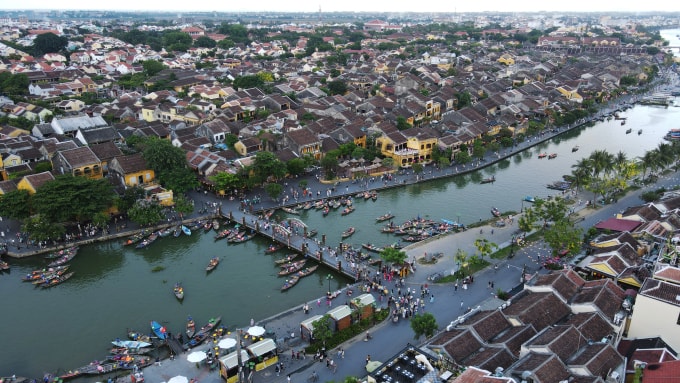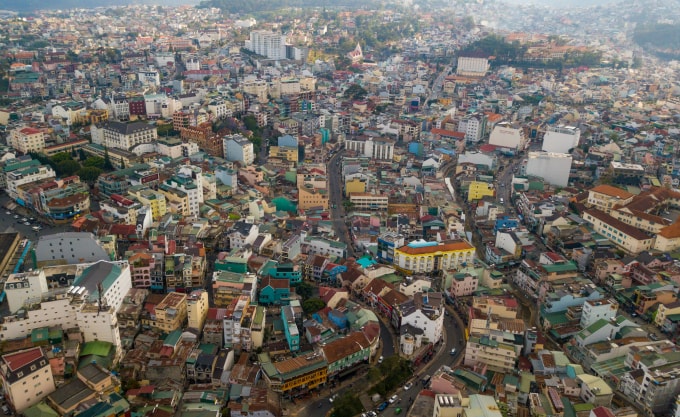Da Lat, Vinh, Nam Dinh, Nha Trang, Viet Tri, My Tho... and dozens of other current urban areas will switch from the model of provincial cities to direct management at the commune and ward levels.

The project to reorganize administrative units and build a two-tier local government model signed by Prime Minister Pham Minh Chinh on April 14 decided to abolish the district level. This means that familiar models such as provincial cities, cities within cities, districts, counties and towns will cease to operate.
The foundation for this breakthrough change stems from the policy unanimously approved by the Politburo, the Secretariat and the Central Committee at the 11th Conference of the 13th Party Central Committee with the ultimate goal of building a more streamlined, effective and efficient state apparatus.
In the new administrative model, the apparatus structure will be simplified, with only the provincial level (including provinces and centrally run cities) and the communal level (including communes, wards and special zones under provinces and cities). All administrative units currently identified as district level nationwide will officially cease operations from July 1, 2025.
Currently, Vietnam has 85 provincial cities, 53 towns, and two special urban areas, Thu Duc (Ho Chi Minh City) and Thuy Nguyen (Hai Phong), which are "cities within cities". Based on the current Law on Organization of Local Government, all of these urban areas are at the district level and will no longer be maintained in the new administrative structure.
Provincial cities and cities within cities have long played the role of important political, economic, cultural, scientific, technical, service and transport hubs of the province, even influencing the inter-provincial or national regions. These urban areas also promote the socio-economic development of the province and neighboring regions.
Among the cities and towns in the province from North to South, there are dozens of urban areas ranging from a few dozen to hundreds of years old, with a rich cultural and historical background. The names of many urban areas have become symbols bearing the mark of time such as Ha Giang, Cao Bang, Viet Tri, Sa Pa, Vinh, Hoi An, Nha Trang, Da Lat, My Tho...
"Provincial cities are the product of long-term development," said Professor Nguyen Quoc Suu, Deputy Director of the Academy of Public Administration and Management.
In contrast to the cities with long histories, the two cities under the city are very young. Thu Duc City was established only 5 years ago, while Thuy Nguyen City is only 4 months old. Many other cities have also been established recently such as Hoa Lu, Dong Trieu, Ben Cat, Phu My.
The distribution of the number of provincial cities is also very diverse. Binh Duong and Quang Ninh are the two provinces with the most provincial cities, each with 5 cities. Quang Ninh includes Ha Long, Uong Bi, Cam Pha, Mong Cai, Dong Trieu, while Binh Duong has Thu Dau Mot, Thuan An, Di An, Tan Uyen, Ben Cat.
In particular, the high level of urbanization is clearly shown in many cities with only wards but no communes, such as Bac Ninh, Tu Son, Thu Dau Mot, Di An, Dong Ha, Soc Trang, Vinh Long.
Tourist cities
160 km from Hanoi, Ha Long City is the capital of Quang Ninh Province, established in 1993, on the basis of Hon Gai Town. Possessing the world natural heritage of Ha Long Bay, this place has become a famous tourist city not only in Vietnam but also in the world. According to the plan of Quang Ninh Province, Ha Long can be divided into 11 wards and 2 communes.
In early 2025, Hoa Lu City was established on the basis of merging Hoa Lu District and Ninh Binh City. Hoa Lu was the capital of Vietnam from 968 to 1010, through three dynasties: Dinh - Tien Le - Ly. This is one of the four core areas of the Trang An World Heritage Complex recognized by UNESCO. The city is expected to be divided into 4 wards: Hoa Lu and 3 wards of the same name divided in the East, West, and South directions.
In the Central region, Hoi An City is located in the lower reaches of the Thu Bon River, recognized by UNESCO as a world cultural heritage in 1999. Hoi An trading port was established in the 15th - 16th centuries and flourished in the following two centuries. This place used to be a major trading center in Southeast Asia. After the country was unified, Hoi An became a town of Quang Nam - Da Nang province.
In early 2008, the Government established Hoi An City in Quang Nam Province. In 2024, Hoi An welcomed 4.4 million tourists, with total revenue of more than VND 5,230 billion. In the near future, three new wards, Hoi An, Hoi An Tay, Hoi An Dong and Tan Hiep commune, will be formed on the basis of separating the current Hoi An City.
Located in the center of Khanh Hoa province, Nha Trang tourist city is several decades old. In 1937, King Bao Dai issued an edict to change Nha Trang from a town to a city. The country was unified, and in March 1977, Nha Trang was upgraded to a city. More than 30 years later, the Prime Minister recognized Nha Trang as a class I urban area, directly under Khanh Hoa province. This place has a beautiful long beach running along the city. Nha Trang Bay has many famous islands, attracting domestic and foreign tourists. This tourist city is planned to be divided into three wards: Nha Trang, North Nha Trang, and South Nha Trang.

Located on the Lam Vien (Lang Biang) plateau, Da Lat was formed in 1893, when Dr. Alexandre Yersin set foot here and convinced the Governor General of Indochina Paul Doumer to build a resort. Since then, Da Lat city was formed, and has experienced many ups and downs. It is expected that Da Lat city will be divided into 5 wards: Xuan Huong - Da Lat, Cam Ly - Da Lat, Lam Vien - Da Lat, Xuan Truong - Da Lat and Lang Biang - Da Lat.
Many other famous tourist cities in Vietnam such as Vung Tau (Ba Ria - Vung Tau province), Phan Thiet (Binh Thuan), Phu Quoc (Kien Giang)... will also be divided into wards, communes or special zones, following the two-level local government model.
Centennial City
Located at the confluence of the Da River, Lo River, Thao River, Viet Tri - the capital of Phu Tho province is also known as "the city of three rivers". This place was formerly the capital of the Van Lang state during the Hung Kings' era. In 2020, Viet Tri was approved by the Prime Minister to become a festival city returning to the roots of the Vietnamese people. By 2040, Viet Tri will be the regional center, the development pole in the Northwest of Hanoi, a national city of tourism, culture and history. According to Phu Tho's arrangement plan, Viet Tri city is expected to be divided into 4 wards and one commune.
Located 90 km northwest of Hanoi, Nam Dinh City has a history of more than 750 years of formation and development. In 1262, the Tran Dynasty built Nam Dinh into Thien Truong prefecture along the right bank of the Red River. In 1831, the Nguyen Dynasty named it Nam Dinh province. Under the Nguyen Dynasty, Nam Dinh was a large city along with Hanoi and Hue. At that time, Nam Dinh also had the Huong and Hoi examinations, and the Temple of Literature.
In 1921, Nam Dinh was recognized as a city by the Governor General of Indochina. After the revolution succeeded, in 1945, Nam Dinh was a city under the authority of the flag (North). During the 11 years from 1945 to 1956, Nam Dinh was a city directly under the Central Government. After that, Nam Dinh City merged into Nam Dinh Province, which is the capital of this locality. It is expected that Nam Dinh City will be divided into 8 wards of the same name, numbered from 1 to 8.
With a history of more than 200 years, Thanh Hoa City was formerly Hac Thanh Town - the economic and cultural center of Thanh Hoa Town. In 1889, Thanh Hoa Town was established. In 1994, Thanh Hoa was upgraded to a city and became a type I urban area in 2014. Thanh Hoa City is expected to be divided into 7 wards, including Hac Thanh numbered from 1 to 4 and Dong Son numbered from 1 to 3.
Vinh City, Nghe An Province is also hundreds of years old. In 1788, Emperor Quang Trung built Phuong Hoang - Trung Do in Yen Truong land, now Trung Do ward, Vinh City. In 1898, King Thanh Thai issued an edict to establish Vinh town. In 1927, the Governor General of Indochina merged Vinh, Ben Thuy, and Truong Thi towns to establish Vinh City.
In the early 20th century, Vinh was a city with many factories, enterprises, ports, trading companies, and banks, attracting tens of thousands of workers. After the country's independence in 1945, Vinh was a town of Nghe An province. Nearly 20 years later, the Politburo established Vinh City. In 2008, Vinh was expanded and became a class I city. It is expected that 6 wards will be separated from Vinh City, including Cua Lo and Vinh 1 to 5.
With an age of more than 340 years, My Tho City was one of the two largest commercial centers in the South in the late 17th century. In the bookGia Dinh citadel informationTrinh Hoai Duc described "My Tho city has tiled houses with carved pillars, high communal houses, large pagodas... boats and ships from rivers and seas are crowded at all intersections, creating a bustling, prosperous metropolis". My Tho was planned to be divided into 5 wards, one of which was named after the current city.
According to the agreed policy, district-level authorities will cease to operate after the National Assembly passes amendments and supplements to the 2013 Constitution and the 2025 Law on Organization of Local Government.
VN (according to VnExpress)